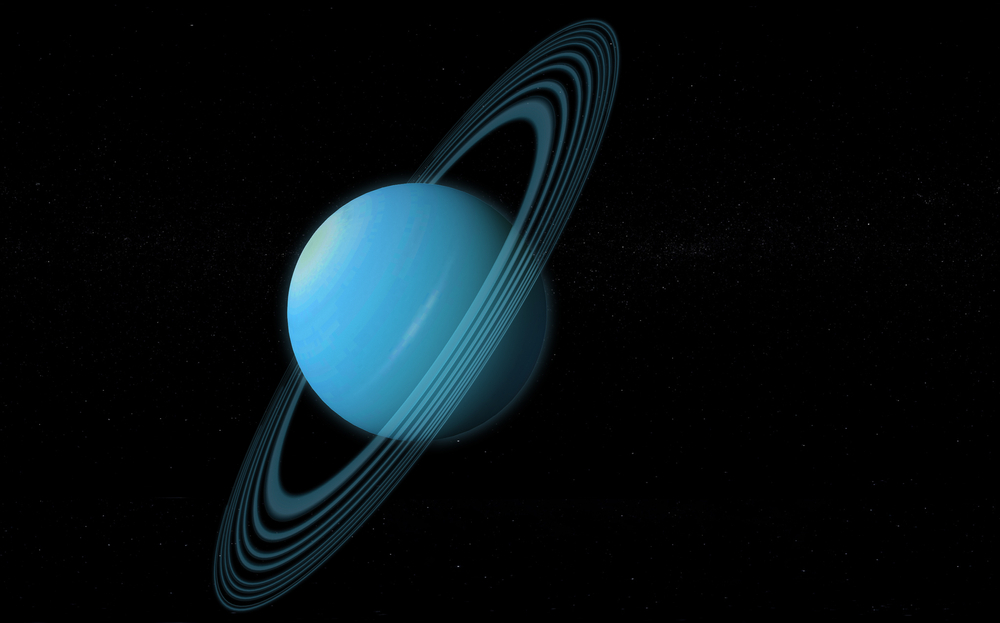Exploring the Unknown: Top 3 Facts About Uranus

Uranus, the seventh planet from the Sun, stands as one of the most enigmatic and fascinating celestial bodies in our Solar System. Known as an “ice giant,” it is a planet that challenges our understanding of planetary formation and behaviour. Despite its remote location, approximately 1.8 billion miles away from the Sun, studying Uranus offers invaluable insights into the complexities of our cosmic neighbourhood.
Unlike any other planet, Uranus is distinguished by its dramatic axial tilt, which essentially has it rotating on its side. This uniqueness, coupled with its faint rings and mysterious icy composition, makes Uranus a compelling subject for both professional astronomers and space enthusiasts alike.
Understanding Uranus not only broadens our knowledge of planetary science but also helps us appreciate the diverse and dynamic nature of the Solar System we inhabit.
Fact 1: The Tilted Axis
Uranus’s axial tilt is one of its most extraordinary features, with the planet tipped over at an angle of approximately 98 degrees relative to its orbital plane. This extreme tilt essentially causes Uranus to rotate on its side, a phenomenon unlike anything seen in the other planets of our Solar System.
The leading theory for this unusual orientation suggests that a colossal collision with an Earth-sized object early in the planet’s history could have caused the dramatic tilt. The consequences of this tilt are profound, leading to extreme seasonal variations. Each pole of Uranus experiences 42 years of continuous sunlight followed by 42 years of darkness, radically impacting its weather patterns.
As a result, the planet exhibits wildly unpredictable atmospheric conditions, including massive storms and fluctuating temperatures, making its climate a subject of intense study and fascination.
Fact 2: The Mysterious Rings
The discovery of Uranus’s rings added yet another layer of intrigue to this already peculiar planet. Detected in 1977 by astronomers James Elliot, Edward Dunham, and Douglas Mink during an occultation event, the rings of Uranus were a surprising find given their faint visibility. Comprised primarily of dark, narrow bands of dust and ice particles, these rings are much less prominent than the dazzling rings of Saturn.
In total, there are 13 known rings encircling Uranus, varying in size and density. Unlike Saturn’s broad and bright rings, which can be seen through a small telescope, the rings of Uranus are dark and narrow, making them much more challenging to observe.
The composition of these rings, possibly imbued with radiation-darkened organics, contributes to their low reflectivity and darker appearance. When compared to other giant planets, Uranus’s rings share a closer resemblance to the tenuous rings of Jupiter and Neptune rather than the iconic and extensive ring system of Saturn.
Despite their subtlety, the rings of Uranus remain a captivating feature of the ice giant, offering valuable insights into the dynamics and history of our Solar System.
Fact 3: The Icy Composition
The composition of Uranus plays a crucial role in defining its unique characteristics and appearance. Primarily consisting of hydrogen and helium, Uranus also contains significant amounts of “ices” such as water, ammonia, and methane.
These ices are not solid but are in a thick, fluid state, due to the high pressures and temperatures within the planet. Uranus’s internal structure is layered with a small rocky core at its center, surrounded by an extensive mantle made up of icy materials.
This mantle is overlaid by a dense atmosphere of hydrogen, helium, and trace amounts of methane gas. Methane, in particular, is responsible for Uranus’s striking blue-green color. The methane in the upper atmosphere absorbs the red portion of sunlight, reflecting back the blue and green hues that we observe.
This distinctive coloring, alongside Uranus’s overall icy composition, continues to intrigue scientists and underscores the importance of studying this distant ice giant to better comprehend the phenomena that shape our Solar System.
Conclusion
In this exploration of Uranus, we’ve delved into three of the most fascinating aspects of this enigmatic planet: its extreme axial tilt, its mysterious rings, and its icy composition. These features not only distinguish Uranus from other planets in our Solar System but also offer valuable insights into planetary science.
Recapping the top three facts, we first examined Uranus’s unusual axial tilt of approximately 98 degrees, which results in extreme seasonal variations and unpredictable weather patterns. Next, we uncovered the discovery and characteristics of Uranus’s rings, which, though faint and narrow, provide important clues about the planet’s history and the dynamic processes at work in our Solar System. Lastly, we explored Uranus’s composition, highlighting the role of methane in its striking blue-green color and the presence of hydrogen, helium, and significant quantities of ices.
The study of Uranus is not just about understanding one planet. It holds broader implications for comprehending the intricate workings of our Solar System. As one of the ice giants, Uranus can help us decode the formation and evolution of planets beyond the rocky ones close to the sun. Furthermore, studying Uranus’s atmosphere, rings, and internal structure enriches our knowledge about the diversity of planetary systems.
As we continue to unlock the mysteries of Uranus, it’s crucial to sustain and expand our exploration efforts. Advanced telescopes and future space missions will play a pivotal role in revealing even more about this distant, icy giant, pushing the boundaries of our understanding.
Let your curiosity drive you to learn more about the wonders of our Solar System. Whether it’s through reading more articles, engaging in discussions, or observing the night sky, there’s always something new to discover. Continue to explore, question, and marvel at the majestic complexity of the cosmos.
Thank you for joining us on this journey through the intriguing world of Uranus in our blog post, “Exploring the Unknown: Top 3 Facts About Uranus”. We hope this exploration has sparked your curiosity and deepened your understanding of this fascinating ice giant.
We’d love to hear your thoughts! Feel free to leave any comments or questions below. Whether you’re an amateur stargazer, a seasoned astronomer, or just someone with a love for the mysteries of the cosmos, your insights and queries are most welcome.
For those eager to delve further into the wonders of our Solar System, we suggest checking out these related articles:
- “The Magnificent Rings of Saturn: A Detailed Overview”
- “Journey to Neptune: Unveiling the Secrets of the Distant Blue Giant”
- “The Enigmatic Moons of Jupiter: A Closer Look at the Galilean Satellites”
Finally, if you found this article enlightening, we encourage you to share it with friends, family, and fellow astronomy enthusiasts. Together, let’s continue to explore, question, and marvel at the majestic complexity of the cosmos.
Stay tuned for more insightful articles and happy stargazing!




